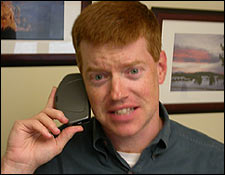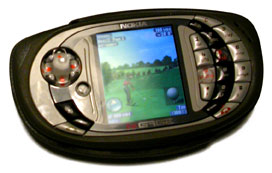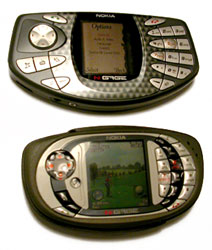
NEW YORK (CNN/Money) -
What I'm about to say could result in me losing face in the gaming world...My friends, the days of sidetalkin' are coming to an end.
For the unaware, sidetalkin' is a term that sprang up last October, pretty much immediately after Nokia introduced the N-gage, a technological fusion of cell phone, gaming device, MP3 player and more. It was born from the unfortunate visual effect achieved when using the N-gage as a phone (by holding it against your cheek lengthwise). Basically, doing so made you look as if you had contracted elephantitis of the ear.
 |
|
| The picture that started Sidetalkin'. |
Before long, a Web site "dedicated" to Sidetalkin' was up – making me its poster child, using a shot we ran in this column to illustrate how silly you would look when talking on the phone (see right). Hundreds of others soon followed. And the N-gage quickly became one of the most ridiculed gaming devices in the industry's history. A $100 price drop and confirmed hacking of the copy protection for N-gage games within six weeks didn't help matters.
Nokia didn't get to be a multibillion-dollar company by ignoring egg on its face, though. Responding to the criticism, the company today unveiled the N-gage QD.
Set for release on June 29 at a standalone price point of $179, the QD isn't the heavily rumored "N-gage 2". It's more like "N-gage 1.5." The egregious design flaws of the original have been corrected, but the platform running the games hasn't changed.
 |
|
| The redesigned N-gage QD. |
Basically, that means that sidetalkin' is through. The N-gage QD can be held like a normal cell phone. Perhaps more importantly, swapping games is no longer an exercise in frustration.
With the first generation of N-gages, changing games or memory cards required you to remove the phone's back cover and battery. It was, at best, a 90 second process. The QD has added a card slot at the bottom of the phone, letting you quickly make any changes externally.
In addition, the company has added a new "hot-start" button, making it easier to navigate the N-gage's (still somewhat complicated) menu structure. Rather than having to press the device's D-pad dead in the center -- something that was always difficult -- Nokia has added a separate button that will activate the feature you've highlighted.
 |
|
| Despite appearances, the screen size on the original N-gage (above) and the QD (below) are the same. |
The QD is about 20 percent smaller than the original N-gage and has a rounder feel and look. It also boasts a longer battery life and a brighter screen (a particularly welcome improvement). It even appears to have a larger viewing screen, though that's just an optical illusion. (The N-gage's screen appears smaller due to a thick black border that surrounds it.)
Rearranging the guts of the N-gage and making it more compact meant jettisoning some of the features that made it unique, though. Gone are the FM radio and embedded MP3 player. And say goodbye to the stereo headset.
Gameplay on the machine hasn't been altered, which can be a positive or negative, depending on your impressions of the N-gage. Nokia's gaming machine was the first to offer true 3D graphics in a handheld. But 3D doesn't necessarily mean better. I've found N-gage games to be somewhat blocky, lacking the smoothness today's gamer has become accustomed to.
And figuring out which buttons correspond to which in-game actions is as tricky as ever.
| EXTENDED PLAY
|

|
|
|
|
In getting my first hands-on time with the QD, I spent a few minutes playing "Ashen" -- one of Nokia's first self-published games for the N-gage. When I struggled a bit with the controls, one of the Nokia representatives called up the help screen explaining the in-game function of various buttons on the number pad.
The amount of information crammed onto the screen was terrifying -- and I quickly went back to button mashing (and had my butt handed to me on a silver platter in a multiplayer game).
As a cell phone, the QD is likely to be more appealing. Nokia said it will announce deals with more cellular providers in the near future. And the QD will also utilize the main bandwidth used for cellular calls in the United States, which the original N-gage did not. More carriers could result in a lower price as well, but that's far from certain.
The N-gage QD is an evolutionary step for Nokia (NOK: Research, Estimates) that may temporarily silence critics, but (at first glance) isn't likely to propel them to a leadership position in the handheld gaming space.
With Sony's (SNE: Research, Estimates) PSP coming soon and Nintendo planning a second handheld system targeting an older audience than the Game Boy Advance, Nokia needs to step things up in a big way.

Morris is Director of Content Development for CNN/Money. Click here to send him an e-mail.
|

